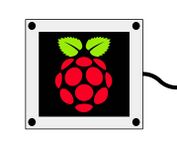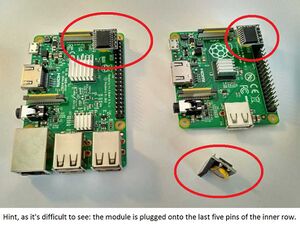LightPi
LightPi 2021
Introduction
The Lightrouter
Up to now, the Lightrouter was our preferred workhorse for collecting and transmitting Lightmeter data. It's low-cost and low-power design allowed for continuous nightsky measurements, automatic data transmission and even - to some extent - remote maintenance.
But, over time several issues surfaced:
- The hardware version 2 of the WR1043ND rendered our firmware image obsolete, leading to a more manual setup routine.
- Future hardware versions will come with a locked firmware, preventing the use of OpenWRT (due to a new FCC rule).
- In offline-scenarios (no NTP, and no GPS) the internal clock performed terrible, exhibiting nonlinear, irregular drifts.
- The internal flash memory is not large enough to hold the entire setup, leading to the need of an overlay filesystem, creating a high dependency on the presence of the USB stick.
- Due to ill-defined brown-out behaviour of the router, the filesystem of several USB sticks got corrupted, leaving the stations paralyzed.
- Our central server died (summer 2016), leaving the reverse-SSH-tunnels dangling in mid-air, and thus preventing remote connections and data collection.
- Power consumption with up to 18W is quite high for solar powered off-grid stations.
- Some gerneral reliability issues.
The LightPi
To combat all these shortcomings, the LightPi is under development. Based on a Raspberry Pi, extended by a realtime module, the LightPi will be easier to set up and to maintain, without increasing the price tag.
Some of it's main features are:
- High and reliable hardware availability, good inter-generation compatibility.
- Higher computing power and full debian-based operating system.
- Lower power consumption (2-4W [Model 3 B], 0.5-1.2W [Model A+]). *
- 4 USB ports (Model B+ upwards), eliminating the USB hub.
- SD-card instead of small onboard flash - no more overlay filesystems.
- Highly accurate DS3231 RTC module (+/-3.5ppm).
- Simple plug-and-play with any FAT32 formatted USB stick for data storage.
- As inexpensive as the Lightrouter.
- Uses A. Trawöger's Lightrouter-"lightmetermini"-python-driver.
*...based on interpolation of various internet sources. Also, I just found this one: https://web.archive.org/web/20190702131047/https://raspi.tv/2019/how-much-power-does-the-pi4b-use-power-measurements
As the LightPi platform is still under active development, several features are not yet implemented:
- Remote shell access (planned).
- Data transmission (partly implemented).
implemented as google drive uploader.
- NTP synchronsiation (partially).
- GPS synchronisation (Yesss! Works now!).
- On-site network service for data access (Yesss! Works now!).
- Independence of a central server infrastructure.
Google drive support circumvents the need for having your own central server.
Current state
The LightPi project's current state is developing / testing , public alpha stage.
Hardware acquisition
LightPi shopping list
- Raspberry Pi (any model)
- DS3231 RTC module
- MicroSD / SD card (dep. on RasPi model) with 4+GB
- Power supply (5V, micro USB)
- USB stick (FAT32 formatted)
- For model A/A+/Zero USB hub
- For model Zero: USB-OTG adapter
- Optional, but recommended: A case for the RasPi
Choosing a Raspberry Pi model
- All "B" models have 2+ USB ports, eliminating the need for an USB hub.
- Also, all "B" models come with an Ethernet port, the A/A+/Zero models do not have native networking capabilities.
- Model 3 B even has it's own onboard WiFi adapter.
- The Models A+/Zero have the lowest power consumption - ideal for off-grid stations.
- Model Zero has no fullsized USB port, thus needing an USB-OTG adapter.
- First generation RasPis (1A and 1B, or just "A" and "B") use full size SD cards, other models use MicroSD.
- Used first/second generation RasPis can be found very cheap on the internet.
- Minimum energy consumption: A+/Zero
- Maximum networking capability: 3B
- Not every model has WiFi (if you need it)
- Be aware of the number of USB sockets you need (but a hub can help)
- RasPi Zero (or Zero W/WH) has the lowest power consumption, but does require an OSB-OTG adapter
- Most of my tests were done on models 1B and 3B/3B+
- Model 4 has a USB-C power jack, earlier models use Micro-USB
- If you have to choose between any (sub-)versions of models 3B/4B: Choose the cheapest
- Make sure that your power supply is sufficient
Setup
Preparation
Hardware
For the setup process you need:
- Your computer
- SD/MicroSD card reader
- HDMI capable monitor
- HDMI cable
- USB mouse
- USB keyboard
(The USB/HDMI items may be borrowed from your computer - no need for a second set.)
Optional, but highly recommended for the setup process:
- Internet connection via WiFi
- USB WiFi adapter (for all models except 3 B)
or:
- Internet connection via Ethernet
- USB Ethernet adapter (for models A/A+/Zero)
Software
The Raspbian image file from https://www.raspberrypi.org/downloads/raspbian/- If you are using Windows: Win32DiskImager
Update 2021-08-10:
Raspbian is now called Raspberry Pi OS, download here: https://www.raspberrypi.org/software/operating-systems/
I do recommend the version "Raspberry Pi OS with desktop", since you get the nice GUI, without too much bloat.
Downloads
Always use the most recent version!
Version v20211104
Improvements:
- Improved Semi-graphical installer
- GPS time sync
- Local WiFi access point
(This version has not yet been thoroughly tested. Your help and feedback is appreciated.)
Further instructions inside.
Version v20170810
Improvements:
- Semi-graphical installer, minimizing the need for command line acrobatics
- Data zipper, moving last months data to a zip archive, greatly reducing disk space consumption
- Google drive uploader, copying completed month-archives to your cloud space
- Heartbeat files, uploaded to your google drive, providing a quick glance at the stations health
Version v20161115
First public version of LightPi.
Instructions inside.
Configuration
| Raspberry Pi Model 3 B (left) and Model A+ (right), outfitted with DS3231 RTC modules (a third one on the bottom right). |
Contact and contribution
You are always welcome to test and give feedback. The easiest way to communicate is to just edit the bulletin board section below.
--Nero2401 (talk) 14:02, 10 August 2017 (CEST)
Bulletin board
...

